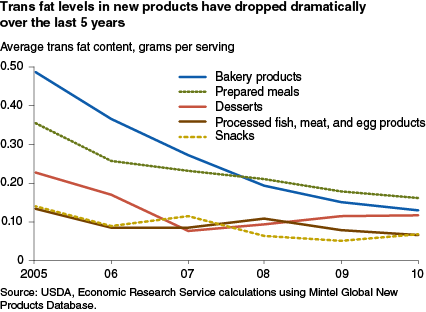Trans Fats Are Less Common in New Food Products
- by Ilya Rahkovsky
- 9/20/2012
In recent years, public health officials have recommended that consumers eat as little trans fats as possible because consumption of trans fats increases the risk of coronary heart disease. Trans fats in foods are mostly formed when vegetable oils are partially hydrogenated. Food manufacturers use these partially hydrogenated oils to prolong shelf life and to substitute for more expensive fats or oils in some shortenings, snack foods, margarines, and baked goods.
The Federal Government has taken two policy approaches to help Americans reduce trans fats in their diets: publicizing the health risks from eating trans fats and requiring food manufacturers to label the trans fat content of foods. Beginning in 2006, Nutrition Facts panels on food labels had to list the amount of trans fats in the food. The health risks of trans fats and regulatory proposals and rules to eliminate trans fats from food products have been widely covered in the media.
ERS researchers found that food manufacturers responded to the labeling requirements, nutritional advice from health officials, and national media coverage by reducing the trans fats in their products. Using the Mintel Global New Products Database, the researchers calculated the average trans fat content of new (including reformulated) products introduced during 2005-10. The five product categories with the highest average trans fat content for new products were bakery products; prepared meals; desserts; processed fish, meat, and egg products; and snacks. New products in these five categories accounted for 46 percent of all new products introduced during the period. In 2005, when the declaration of trans fat content was voluntary and trans fat levels were most likely underestimated, average trans fat content ranged from 0.49 grams per serving for the 426 new bakery products to 0.13 grams per serving for new processed fish, meat, and egg products.
By 2010, the 703 new bakery products introduced that year contained an average of just 0.13 grams of trans fat per serving, a decline of 73 percent from amounts in 2005. Trans fat levels for new prepared meals declined by 54 percent between 2005 and 2010, and levels for new processed fish, meat, and egg products and new snacks fell about 51 percent. The average trans fat content for new desserts was 0.23 grams per serving in 2005, dipped to 0.08 grams in 2007, and rose to 0.12 grams in 2010. Lower levels of trans fats in new food products make it easier for consumers to comply with dietary advice to keep trans fat intake as low as possible.
This article is drawn from:
- Rahkovsky, I., Martinez, S. & Kuchler, F. (2012). New Food Choices Free of Trans Fats Better Align U.S. Diets With Health Recommendations. U.S. Department of Agriculture, Economic Research Service. EIB-95.


